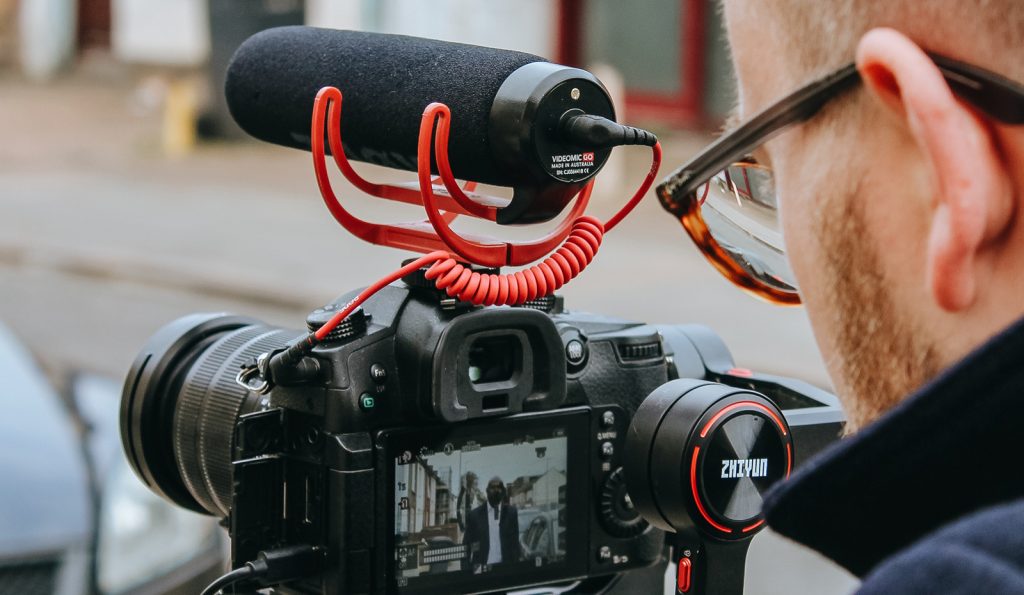
You don’t need me to tell you that video content is king right now. And queen. Head over to any social media platform, profile, or web page, and you’ll see that anybody who is anyone is making video content. It’s everywhere, and it’s drawing people in. You could easily argue that video content is the most successful form of digital content to ever have existed.
While traditionally reserved for big companies with big budgets, modern technology now means that literally anyone can pick up a smartphone or affordable camera and make their own video content as well as having the chance to go viral. And believe me, they are doing just this.
Let’s look at the stats specifically for video marketing, all thanks to HubSpot.
- 54% of people want to see more video content from companies.
- 83% of worldwide consumers prefer watching YouTube content that enjoying any other type of content
- 73% of people prefer videos to images on social media and find them far more ‘entertaining.’
- As of 2019, video is now the most utilized form of media in video marketing
You can’t deny the facts.
In today’s hyper-connected world, even the craziest and seemingly ‘nothing’ videos can garner millions of views and can skyrocket people into stardom and, whereas companies can invest millions into video marketing and be slammed into the ground and actually worse off than where they started.
Putting all this together, you’re going to be left with one question because you can already see that it’s basically essential to make sure you’re creating video ads for your company and business in one way or another. The real question is, how do you make high-quality video ads that get results?
While there’s no right or wrong way to do this; as I said above, even the most seemingly generic video has the opportunity to go viral; there are plenty of tips out there that can help increase your chances. In today’s post, I’m going to share with you ten of the best tips you need to know.
1. Understanding your Audience
The absolute first thing you need to do before you even thinking about what kind of video content you’re going to start creating and producing is what audience you’re catering for. Just like every other kind of content you could be making, if you don’t know who you’re marketing to, then it’s basically impossible to get it right.
For example, let’s say you’re a website that sells mountain bikes and accompanying equipment. Are you selling to families? Children? Adults? Athletes? Professional mountain bikers? Explorers? Teenagers? Girls? Boys?
What kind of price is your stock, and what kind of income should people have to be interested in what you’re offering? What country are these people in, and what kind of culture do they have?
These are all questions you need to ask yourself because you would try and sell a 15-year old girl whose parents are probably buying her the bike far differently than you would an athlete who’s looking to perform on the world stage.
This sounds really simple and something you should know already, but you’ll be surprised by how many businesses don’t do this as detailed as they can. The more detail you have, the more likely you are to be able to create content that will target the specific niche you’re trying to market too.
In short, gather as much detail as you can, create an image of your ideal target market, and then create a video for this specific profile.
2. Always Tell a Story
Storytelling is the most powerful marketing tool out there. You’ve seen charity requests for dog’s homes and the sorts, and you’ve seen how the advert will follow the story of one dog who was found in a really bad condition, was picked up by the home, brought back to health, adopted by a good family, and now they’re living happily ever after.
You could call this a case study of sorts, but the truth is that it’s a story of the dog’s journey, and people relate to stories more than anything. Watch any highly enjoyed and high-rated advertisement online, and you’ll see that in one form or another, all these pieces of video content tell a story that hooks the watcher and wants them to want to know more.
How you make a story is to think about what message you’re trying to send and what your goal is. Let’s say you’re selling trainers. You could show a child growing up and going to a sports day at school wearing your trainers. As they get older, they train more and more, and you highlight reel their journey all the way to the Olympic Games where they win gold.
Throughout this inspiring story, you’re showing that your trainers were there with the individual the whole time. Every step of the way. Thank me for the idea later, Nike. You can have ideas already, or you can write a script to help. It doesn’t matter how you do it; you just need to incorporate a story into your advert. Don’t forget to make it visual!
3. What Resources Do You Have?
While we’re going to talk a little bit more about digital resources at the end of this post, it is, of course, so important to think about what physical resources you’re going to be working with to define the scope of your video project and how you’re going to tackle actually making the video content itself.
Are you going to record and edit it all yourself, or are you going to outsource it to a third-party company? Of course, using another company is very expensive, so it can really pay to make it yourself, especially since making a video yourself has never been easier, nor more affordable.
In reality, you can actually make video content using just your smartphone, but I will recommend if you’re making ad content, then you need to buy a tripod and a microphone to dramatically raise the quality of your content. If you want to upgrade, you’ll need to think about getting yourself a digital camera, which will cost several hundred dollars for one that comes with all the features you’re going to want.
You’ll then need to think about editing software and which applications you want to use to piece all your footage together and add things like music and effects. There are free and premium options out there, but you’ll need to define what you’re trying to create, and then what software can help you achieve that goal quickly and effectively.
You’ll also want to take time to think about training. How up to date are you on recording video content or using your preferred editing software? If you’re not at all, is there someone within your business who is trained in doing this, or will you pay to train someone up?
If you don’t know what you’re doing, it can be incredibly difficult and time-consuming to get started, but it is one of those things that once you know how to do it, you can then produce high-quality video content for life. If you have an interest or passion for making video content, then it’s definitely going to be something you’ll want to invest in.
At the end of the day, think about what resources you have to work with, what resources you’re going to need, and then think about how to start small and then build up the kind of content you’re producing. You don’t need to have a AAA budget or professional cameramen when you’re just starting out.
4. Define What Type of Video You’re Making
When you’re making a marketing video, you’re not just picking up a camera and recording something. You’re instead creating a video for a specific purpose, and if you’re not aware of what this purpose is, then you’re almost guaranteed to miss the mark of what you’re aiming to achieve.
Think about some of these video types you could be making;
- A demo video
- A brand awareness video
- An expert interview
- A promotional video
- An event promo
- An animated video
- An explainer video
- An educational video (a how-to video)
- A live video
- A 360-degree video
- A case study video
- A user-generated video
- A personalized video
“These terms cover most of the basic video types you’ll be making, and each video types have its own way of working, best practices, and things you should avoid. However, while all that is a guide within itself, the important thing for you to remember is to make sure you’re choosing one topic, educating yourself on the dos and don’ts for each one, and then following the guidelines,” says Sarah Duncan, a video expert at DraftBeyond and Researchpapersuk.
This will save you from making your video too confusing for your audience and producers and will help you really nail down what kind of message you’re sending.
5. Keep Your Videos Short and Sweet
What do all these platforms have in common? Snapchat. Facebook Videos. Instagram Videos. Instagram Reels. YouTube Shorts. Twitter Highlights. Vine. Tiktok. Of course, all the video content that are on these platforms are short. And I mean really short.
Attention spans are so tiny these days, which is why so many platforms create video content that is around the seven-second mark. It’s short. It’s sweet. It’s entertaining. It gets the job done and sends the message the producer is trying to send.
Now, I’m not saying that long form content doesn’t work. You can make two-hour-long documentaries and movies, and you can make 20-minute vlogs and they work, but it depends on your audience.
In this post, we’re talking about video ads, which means you’re probably going to be popping up before the start of YouTube videos and on the promoted posts section of someone’s timeline. These people aren’t going out of their way to look for your content, so you need to not hold them up as they do.
You want to be short and sweet. In literal seconds, you want to grab someone’s attention, send your message, and get out. Holding someone up for too long is going to get them irritated with your business because they just want to get to wherever they’re going, and this is going to form a negative image of you in their minds, and they won’t want to buy from you.
As I said, keep things short and simple, a couple of seconds most. Get in, get out, and you’ll have far more of an impact on your audience members.
Statistics also show that around 5% of viewers will stop watching content after 5 seconds, and 60% will stop after two minutes, so this is the kind of timeframe you’re working with.
6. Work to a Budget
We’ve spoken a lot about resources and research and production of your video content, and yes, if you’re wondering, this can all get very expensive if you let it run away with you. Before every video project you get stuck into, you need to make sure you’re setting and sticking to a budget.
Otherwise, you’re going to end up spending a fortune that you don’t have, and this won’t be great for your business. Research how much things are going to cost you and again, start small. You don’t need to go massive for your first project. Start by making a short ten second video and then go from there. This way you’ll also be able to manage your costs much easier.
7. Stay on brand
I shouldn’t have to write this, but it’s crazy to see how many businesses don’t take this point on board. Just like all the other content you’re producing, your video content needs to be on brand with who your business is and how your customers see you.
If you’re a professional B2B company and you’re keeping things professional, but your video is super light-hearted and causal, your customers aren’t going to be aware they’re dealing with the same business. Always stay on brand and keep everything consistent.
8. The Best Bit First
“Hand in hand with some of the attention-span points we’ve explored; you need to ensure you’re making the first five seconds of your video the best they can possibly be. People are going to look at your video, and within those five seconds, they’ll decide whether they keep watching or they skip,” explains Nick Harper, a tech writer at Last Minute Writing and Writinity.
Make it count.
9. Analyse and Improve
Just as you should be doing with all your other content, every single video you release, you need to ensure you’re analyzing how well it’s going and highlighting what you did good, and what you can do better.
This way, you won’t just be mindlessly heading into every video project, but you’ll know how you need to improve and what you can do to create the best video content possible.
10. Find the Ideal Resources
This final point may seem like a no-brainer, but again, you’ll be surprised by how many individuals and businesses don’t take the time to pick out the right resources for the videos they’re creating. In all honesty, you probably won’t be surprised since perhaps you’ve experienced this yourself already.
Think about the video content you’ve seen where the camera shots or stock footage hasn’t looked right. Perhaps the song was off and didn’t suit the advert, and you’re left thinking ‘eww, that didn’t work,’ or ‘I would have done that differently.’
Finding the right music and footage for your video project is no easy feat, especially when you’re on a budget, and you may not have access to the content you originally have in mind, meaning you need to compromise. Fortunately, there are plenty of platforms and services out there that can help.
From Shutterstock to Epidemic Sound and even YouTube’s own audio library; for a small cost, there are paid and free services out there, but don’t rush in and just pick the first song or track you think sounds okay. The audio and visuals of video content are so important for telling your narrative and sending your message, so make sure you’re taking your time to pick the right one.
While on this point, you may be wondering why I’m saying choosing your own footage. Surely, you’ll be recording your own? While this is true, you wish to pad out your video with relevant stock content, which helps propel your message. However, you should only use this content if it really does add a new dimension to your content, not just because it looks nice.





